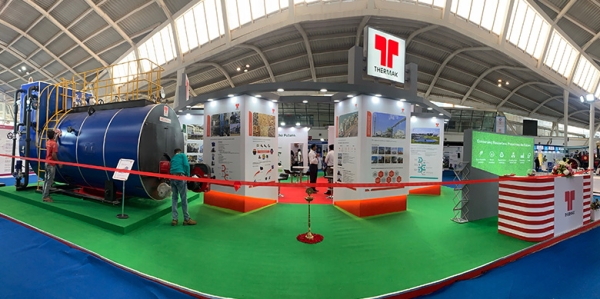Tata Power has a fix for the missing link in green- energy: The Government of Maharashtra and Tata Power have signed a memorandum of understanding for a 2800MW pumped hydro storage project in the state. Image credit: tatapower.com Tata Power has been investing in pumped storage hydropower, a technology that can potentially shape India's sustainable-energy future. The company is planning a capital investment of INR13,000 crore in two such storage projects in Maharashtra. The company is betting on pumped storage hydropower, which is emerging as a reliable and versatile technology that can shape India's sustainable- energy future. It has proposed a capital investment of INR13,000 crore in two such storage projects in Maharashtra - a 1,800 megawatt (MW) unit at Shirawata in Pune district and a 1,000MW unit in Bhivpuri in Raigard district. Tata Power's strategy makes immense business sense as energy-storage solutions are gaining prominence amid the world's shift towards renewable-energy sources. Green power can become fully mainstream if it is stockpiled efficiently. "We are targeting by mid-2024 to start work on both the pumped hydro plants," says Praveer Sinha, chief executive officer of Tata Power. The Bhivpuri plant is slated to get ready in 36-40 months and the Shirawata unit will take a little longer, about 48 months. "By the end of 2027, we will be able to offer power from the Bhivpuri plant. From 2027-28 onwards, we will be able to offer blended 24/7 renewable power to consumers from both these plants," Sinha elaborates. At present, over 38% of its generating capacity comes from clean and green- energy sources such as solar, wind, and hydro. The remaining 62% comes from thermal. In 2015, the share of clean energy was a mere 16%, and thermal was 84%. Its clean-energy portfolio currently stands at 5,500MW, or nearly 38% of the installed capacity. Of this, nearly 3,200MW is solar, 1,000MW is wind, and the rest is hydro and off-gas. Another 3,760MW is under implementation which is likely to be completed in the next two years. "We will achieve an installed capacity of 9,300MW clean energy, which will be nearly 50% of our total capacity. So, we have set up a very ambitious target that by 2030, 70% of our installed capacity will be clean energy. I think we'll be able to achieve this," Sinha says. Unlike NTPC and other energy producers that are still operating coal-based power plants, Tata Power aims to phase out all coal-based generation by 2045, when most of its plants' life expires. In fact, its thermal portfolio has increased by a mere 2.3% CAGR between March 2015 and March 2023, with no additions since 2020. At the same time, the company's renewable-generation portfolio has grown rapidly at a CAGR of 18.4%, almost four times over the same period. source: et
India needs to do to be a developed country by 2047: GDP ranking isn't the benchmark to focus on if the country wants to be a truly developed economy, say experts. Improvements in other economic and social parameters are more important. The next 25 years are crucial for India, going by the government's vision. It is the time to take the strides required to make the country а developed nation. To reach this goal, various economic and social indicators must see continuous growth. Then,what are the parameters that lend definition to a developed country? Is India equipped to achieve these targets by 2047, which marks the 100th year of independence? According to the World Bank, the economies of the world are classified into four income groups-low, lower-middle,upper-middle and high. Former member of the Planning Commission Arun Maira categorically states that just a high rank in GDP will not take the country where we aim to be. "We may be first five in GDP rankings, but we are ranking towards the bottom as far as per capita incomes are concerned. Nigeria and India are now comparable in per capita incomes. Increasing GDP without caring about healthcare, free education, wages of farmers or workers in the unorganised sector will not yield any results. Our strategy is wrong," he states emphatically. Sudhir Kapadia, Senior Partner, EY India, is of the view that the right enablers should be created for growth to come by. He cautions against falling into the "middle- income trap," and slowing down economically after the initial period of growth. "The challenge will be to grow from the middle-income per capita to the developed-country per capita-that last hurdle is the most difficult because the growth that comes in the initial years of being an enabler can just be a combination of various geopolitical or domestic factors. The World Bank stated in its overview of India: "India's aspiration to achieve high income status by 2047 will need to be realised through a climate-resilient growth process that delivers broad- based gains to the bottom half of the population. Growth- oriented reforms will need to be accompanied by an expansion in good jobs that keeps pace with the number of labour market entrants." The next 25 years can be India's make or break moment. This is the chance for India to leap ahead and create history. source:et
5 midcap stocks with right levels of RoE and upside up to 44%: Mid-cap stocks are able to outperform border market indices. What these tailwinds are going is that they have pushed valuations to a much higher level. This increases the challenge of buying the stocks. If the right financial parameters and other filters are applied, it may lead to a set of select stocks of potential gainers.But before buying any stocks from any segment of the market, especially midcap, it is time to put more and stricter checks and balances in place. There is a range for each sector and industry. Expecting a commodity business to have double digit margins year after year would be wrong, though there would be time when metal companies will mint money, but then suffer for a long time when metal prices remain under pressure. In order to look for such companies, different combinations of profitability ratios have been used. So, stocks with a minimum return on equity of 14% is considered. Mid Cap Stocks with Net Margin & RoE Upside Potential-Dec 9, 2023 Company Natco Pharma Name Avg 8 Score Reco Hold Analyst 14 Count Upside 44.8 Potential Net 31.6 Margin % RoE% 22.9 Inst 19.0 Stake% Market 13,973 Cap Rs Cr Company Finolex Cables Name Avg 7 Score Reco Buy Analyst 7 Count Upside 31.8 Potential Net 13.5 Margin RoE% 14.9 Inst 22.5 Stake% Market 15,780 Cap Rs Cr Company Can Fin Homes Name Avg Score Reco Buy Analyst 17 Count Upside 26.5 Potential Net 20.8 Margin% RoE% 18.0 Inst 354 Stake% Market 10,525 Cap Rs Cr Company VRL Logistics Name Avg 3 Score Reco Buy Analyst 9 Count Upside 25.6 Potential Net 10.7 Margin % RoE% 36.1 Inst 35.1 Stake% Market 6,202 Cap Rs Cr Company Engineers India Name Avg 7 Score Reco Buy Analyst 7 Count Upside 14.9 Potential Net Margin 142 RoE% 23.5 Inst 18.9 Stake% Market 8,605 Cap Rs Cr Calculated from highest price target given by analysts source:et
Stock picks of the week: 6 stocks with consistent score and upside up to 25%: The nifty once again forms a new high and crosses some of the psychological barriers. The mood of the markets is clearly bullish, while it might appear that one is trying to spoil the party, by adding words like caution and high valuations at this point of time. Oil prices have come down, that is the reason we saw oil marketing and refining companies stocks performing well in the last couple of days. If things remain this way, it is very likely that we will see companies from sectors like paints and others also do well, because oil derivatives are a major part of raw material cost for these companies. Metal prices have remained subdued for some time, which means that while metal companies may not see a sharp jump in their bottomline, the user industry like automobiles would be able to show better performance as they have shown in last quarter results. The selected list applies different algorithms for all BSE and NSE stocks. The list further by selecting only those stocks with an average recommendation rating of either "Strong Buy" or "Buy" or "Hold". Stocks with Consistent Score Improvement Dec 9, 2023 Company Century Plyboards Name Latest Stock & Score Stock Score Stock Score Mago Reco Buy Analyst 19 Count Upside 252 Potential (%) 1M Returns 48 Inut Stake 186 (%) Market Cap Mid Type Market Cap 15248 Rs Cr Company Cholamandalam Investment & Finance Co Name Latest Stock 8 Score Stock Scare 7 1W ago Stock Score 5 IM ago Reco Analyst 33 Buy Count Upside 226 Potential (চ) 1M Returna 2.1 Inat Stake 30.9 (6) Market Cap Large Type Market Cap 97,995 Rs Cr Company Chalet Hotels Name Latest Stock Score Stock Score 7 1W ago Stock Score 6 Mago Reco Strong Buy Analyst 13 Count Upside 21.6 Potential (6) 1M Returns 05 Inst Stake 21.3 (%) Market Cap Mid Type Market Cap 11.972 Rs Cr Company Name Muthoot Finance Latest Stock Score Stock Score 7 1W age Stock Score 6 1M ago Reco Buy Analyst 22 Count Upside 21.5 Potential (4) 1M Returna 8.9 inst Stake 18.9 (6) Market Cap Large Type Market Cap 57.810 Rs Cr Company Godrej Agrovet Name Latest Stock Score Stock Score 1W ago Stock Score 6 1M ago Reco Analyst Count Upside Potential (%) Hald 1M Returns 99 Inst Stake 140 (%) Market Cap Mid Type Market Cap 9,999 Rs Cr Company Power Grid Corp Name Latest Stock 9 Score Stock Score 1W ago Stock Score 1M ago Reco Analyst Count Upside Potential (3) Buy 16 1M Returns 10.4 source: et
वेदांता रिसोर्सेज स्टैंडर्ड चार्टर्ड बैंक से 1.25 अरब डॉलर जुटाने के करीब: बताया जाता है कि स्टैंडर्ड चार्टर्ड बैंक $1.25 बिलियन के वित्तपोषण में से $950 मिलियन का दायित्व लेगा, जबकि न्यूयॉर्क स्थित सेर्बेरस कैपिटल शेष $300 मिलियन को कवर करेगा। यह कि अन्य क्रेडिट निवेशक भी इसमें शामिल हो सकते हैं क्योंकि स्टैंडर्ड चार्टर्ड बैंक द्वारा ऋण के अपने हिस्से को वितरित करने या "बेचने" की उम्मीद है। भारत के तेल-से-धातु समूह वेदांत की लंदन स्थित माता-पिता, स्टैंडर्ड चार्टर्ड बैंक और सेर्बेरस कैपिटल मैनेजमेंट से संयुक्त रूप से लिए गए 1.25 बिलियन डॉलर के ऋण को अंतिम रूप देने के करीब है, जो जनवरी में होने वाले बांड पर डिफ़ॉल्ट को रोकने में मदद कर सकता है, लोगों ने कहा मामला। लोगों ने नाम न छापने का अनुरोध करते हुए कहा कि स्टैंडर्ड चार्टर्ड बैंक $1.25 बिलियन के वित्तपोषण में से $950 मिलियन का दायित्व लेगा, जबकि न्यूयॉर्क स्थित सेर्बेरस कैपिटल शेष $300 मिलियन को कवर करेगा। उन्होंने कहा कि अन्य क्रेडिट निवेशक भी इसमें शामिल हो सकते हैं क्योंकि स्टैंडर्ड चार्टर्ड बैंक द्वारा ऋण के अपने हिस्से को वितरित करने या "बेचने" की उम्मीद है। लोगों ने कहा कि ऋण की अवधि 'हाई टीन्स' में ब्याज दर के साथ लगभग तीन साल हो सकती है। स्टैंडर्ड चार्टर्ड बैंक डेविडसन केम्पनर के साथ बातचीत कर रहा है। लोगों ने कहा कि ऋण की अवधि 'हाई टीन्स' में ब्याज दर के साथ लगभग तीन साल हो सकती है। स्टैंडर्ड चार्टर्ड बैंक अपनी 950 मिलियन डॉलर की ऋण प्रतिबद्धता के एक हिस्से को वितरित करने के लिए डेविडसन केम्पनर, एरेस मैनेजमेंट और वर्डे पार्टनर्स के साथ बातचीत कर रहा है। source:et
40% तक की बढ़त के साथ 6 पूंजीगत सामान और इंजीनियरिंग स्टॉक: पूंजीगत सामान और इंजीनियरिंग कंपनियों को कई वर्षों तक कठिन समय का सामना करना पड़ा था। इस तथ्य को देखते हुए कि किसी भी उद्योग में शायद ही कोई क्षमता निर्माण हो रहा था, कई लोगों को अपना उत्पाद पोर्टफोलियो बदलना पड़ा और उन्हें बहुत कम मार्जिन के साथ रहना पड़ा। लेकिन अब सारी कोशिशों के कुछ नतीजे सामने आने लगे हैं. तीन चीजें पूंजीगत वस्तुओं की मांग को प्रभावित करती हैं। पहला, सरकार द्वारा खर्च, निजी क्षेत्र द्वारा खर्च। अंतिम लेकिन सबसे महत्वपूर्ण बात सरकारी नीतियों का फोकस। पूंजीगत सामान स्टॉक - ऊपर की ओर संभावना 8 दिसंबर, 2023 कंपनी का नाम थर्मैक्स अपने मित्रों के साथ सदस्य-मात्र साझा करें या उन्हें निःशुल्क प्रतिक्रिया देने में सहायता करें इस स्टोर को उपहार में दें आ फ़ॉन्ट आकार सहेजें ड्रिंट इस सेंट को रेट करें औसत स्कोर रेको पकड़ना विश्लेषक गणना 22 उपरी संभावना 40.82 उदाहरण हिस्सेदारी 22.9 मार्केट कैप प्रकार बड़ा बाजार पूंजीकरण करोड़ रु 32,152 कंपनी का नाम सीमेंस औसत स्कोर 7 रेको खरीदनाविश्लेषक गणना 23 उपरी संभावना 28.91 उदाहरण हिस्सेदारी% 97 मार्केट कैप प्रकार बड़ा बाजार पूंजीकरण करोड़ रु 136,542 कंपनी का नाम टिमकेन इंडिया औसत स्कोर 6 रेको पकड़ना विश्लेषक गणना 6 * उपरी संभावना 27.96 उदाहरण हिस्सेदारी% 219 मार्केट कैप प्रकार बाजार पूंजीकरण करोड़ रु कंपनी का नाम बड़ा 24,028 त्रिवेणी टर्बाइन औसत स्कोर रेको खरीदना विश्लेषक गणना उपरी संभावना 27.31 उदाहरण हिस्सेदारी 27.1 मार्केट कैप प्रकार मध्य बाजार पूंजीकरण करोड़ रु 13.244 कंपनी का नाम किर्लोस्कर ऑयल इंजन औसत स्कोर 6 रेको मजबूत खरीदें विश्लेषक गणना 2 उपरी संभावना 17.16 उदाहरण हिस्सेदारी 33.8 मार्केट कैप प्रकार मध्य बाजार पूंजीकरण करोड़ रु 8,654 कंपनी का नाम एआईए इंजीनियरिंग औसत स्कोर रेको खरीदना विश्लेषक गणना 14 16.57 उपरी संभावना उदाहरण हिस्सेदारी 32.9 मार्केट कैप प्रकार बड़ा बाजार पूंजीकरण करोड़ रु 35,506 विश्लेषकों द्वारा दिए गए उच्चतम मूल्य लक्ष्य से गणना की गई source: et
निफ्टी फाइनेंशियल सर्विसेज स्टॉक 15% से अधिक रिटर्न दे सकते हैं: निजी क्षेत्र के बैंकों द्वारा वापसी की कोशिश के कुछ शुरुआती संकेत मिल रहे थे। हालाँकि, असुरक्षित ऋण देने पर अंकुश लगाने के आरबीआई के फैसले ने भावना को उनके खिलाफ कर दिया। लेकिन केवल भावना, वास्तव में क्या इससे उनके दीर्घकालिक परिप्रेक्ष्य में कोई फर्क पड़ेगा, यह बहस का विषय है और उत्तर का शीर्षक 'नहीं' है। 8 दिसंबर, 2023 की नवीनतम स्टॉक रिपोर्ट प्लस रिपोर्ट में निफ्टी फाइनेंशियल सर्विसेज इंडेक्स में स्टॉक की निम्नलिखित सूची को "मजबूत खरीद/खरीद/होल्ड/सेल" की सिफारिश दी गई थी। विश्लेषकों की सिफारिशें संस्थागत ब्रोकर्स अनुमान प्रणाली का उपयोग करके प्रदान की जाती हैं ( IBES) आपको कार्रवाई योग्य अंतर्दृष्टि प्रदान करने के लिए। आप सूचकांक में प्रत्येक स्टॉक को खरीदने/बेचने/होल्ड करने की सिफारिशें देने वाले विश्लेषकों की संख्या का विवरण भी देख सकते हैं। रिफ़िनिटिव, एक व्यापक शोध रिपोर्ट है जो मानकीकृत स्कोर उत्पन्न करने के लिए 4,000+ सूचीबद्ध शेयरों के पांच प्रमुख घटकों - कमाई, बुनियादी सिद्धांत, सापेक्ष मूल्यांकन, जोखिम और मूल्य गति का मूल्यांकन करती है। उपरोक्त पांच घटक रेटिंग का सरल औसत आम तौर पर औसत स्कोर तक पहुंचने के लिए वितरित किया जाता है। प्रत्येक स्टॉक को 1 से 10 के पैमाने पर रैंक किया गया है। 8 से 10 के स्कोर को सकारात्मक माना जाता है, 4 से 7 को तटस्थ और 1 से 3 को नकारात्मक दृष्टिकोण दिया जाता है। स्कोर के अलावा, रिपोर्ट में प्रवृत्ति विश्लेषण, सहकर्मी विश्लेषण और औसत विश्लेषकों की सिफारिशें भी शामिल हैं। अपसाइड पोटेंशियल - 8 दिसंबर, 2023 तालिका में खोजें कंपनी का नाम औसत स्कोर रेको विश्लेषक गणना उपरी संभावना% उदाहरण हिस्सेदारी % बाजार पूंजीकरण करोड़ रु कंपनी का नाम बजाज फाइनेंस 9 खरीदना 31 19.3 21.3 456,985 औसत स्कोर रेको विश्लेषक गणना आईसीआईसीआई बैंक 9 मजबूत खरीदें 40 उपरी संभावना% उदाहरण हिस्सेदारी % बाजार पूंजीकरण करोड़ रु 19.1. 53.4 700,703 कंपनी का नाम औसत स्कोर रेको विश्लेषक गणना एचडीएफसी बैंक 6 खरीदना 40 उपरी संभावना% 18.4 उदाहरण हिस्सेदारी % 49.6 बाजार पूंजीकरण करोड़ रु 1,237,588 कंपनी का नाम स्टेट बैंक ऑफ इंडिया औसत स्कोर 9 रेको विश्लेषक गणना खरीदना 41 उपरी संभावना% 15.7 उदाहरण हिस्सेदारी % 27.4 बाजार पूंजीकरण करोड़ रु 546,052 source: et
Vedanta resources close to raising $1.25 billion from Standard Chartered Bank: Standard Chartered Bank will underwrite $950 million of the $1.25 billion financing while New York- based Cerberus Capital will cover the remaining $300 million, the people said requesting anonymity. Other credit investors could join as Standard Chartered Bank is expected to distribute or "sell down" its share of the loan, they added. Vedanta London-based parent of India's oil-to-metals conglomerate Vedanta, is close to finalizing a $1.25 billion loan availed jointly from Standard Chartered Bank and Cerberus Capital Management that could help it avert a default on bonds due in January, said people aware of the matter. Standard Chartered Bank will underwrite $950 million of the $1.25 billion financing while New York- based Cerberus Capital will cover the remaining $300 million, the people said requesting anonymity. Other credit investors could join as Standard Chartered Bank is expected to distribute or "sell down" its share of the loan, they added. The loan could have a tenor of about three years with interest rate in the 'high teens', the people said.Standard Chartered Bank is in talks with Davidson Kempner. The loan could have a tenor of about three years with interest rate in the 'high teens', the people said.Standard Chartered Bank is in talks with Davidson Kempner, Ares Management and Varde Partners to distribute a portion of its $950 million loan commitment. source:et
स्टॉक रिपोर्ट पर इन शेयरों ने 10 पर 10 अंक प्राप्त किए: Refinitiv, 4,000+ सूचीबद्ध शेयरों के लिए विस्तृत कंपनी विश्लेषण करता है। विस्तृत कंपनी विश्लेषण के अलावा, रिपोर्ट प्रत्येक घटक के लिए विश्लेषकों के पूर्वानुमान और प्रवृत्ति विश्लेषण का भी मिलान करती है। स्टॉक रिपोर्ट्स प्लस में औसत स्कोर की गणना पांच प्रमुख निवेश उपकरणों - कमाई, बुनियादी बातों, सापेक्ष मूल्यांकन, जोखिम और मूल्य गति का मात्रात्मक विश्लेषण करके की जाती है। अनुमान संशोधन विश्लेषकों द्वारा कंपनी की प्रति शेयर आय में ऊपर और नीचे संशोधन की संख्या और उन संशोधनों का औसत प्रतिशत परिवर्तन है। रिपोर्ट में बुनियादी घटक के तहत लाभप्रदता, ऋण, कमाई की गुणवत्ता और लाभांश रुझान का मूल्यांकन किया जाता है। प्रत्येक उप-घटक को 1 से 10 के पैमाने पर रैंक करने के लिए समान महत्व दिया जाता है। सापेक्ष मूल्यांकन के तीन घटक होते हैं - बिक्री की कीमत (50% भार), पिछला पी/ई (25% भार) और आगे का पी/ई (25) % वज़न)। इन मेट्रिक्स का मूल्यांकन समग्र बाजार, सूचकांक और कंपनी के अपने ऐतिहासिक 5-वर्षीय औसत के आधार पर किया जाता है। अस्थिरता, रिटर्न का परिमाण, बीटा और सहसंबंध सहित दीर्घकालिक (5-वर्ष) और अल्पकालिक (90-दिवसीय) स्टॉक प्रदर्शन उपायों की एक श्रृंखला का मूल्यांकन करके जोखिम स्कोर। प्रत्येक कारक को समान रूप से महत्व दिया जाता है। सबसे कम जोखिम वाले शेयरों को 10 की जोखिम रेटिंग दी जाती है। साप्ताहिक रिपोर्ट दो तकनीकी प्रदर्शन कारकों के संयोजन के आधार पर मूल्य गति रेटिंग की गणना करती है: सापेक्ष शक्ति (70% वजन) और मौसमी (30% वजन)।पूंजीगत सामान स्टॉक - ऊपर की ओर संभावना 8 दिसंबर, 2023 कंपनी का नाम थर्मैक्स औसत स्कोर 6 रेको पकड़ना विश्लेषक गणना 22 उपरी संभावना % 40.82 उदाहरण हिस्सेदारी% 22.9 मार्केट कैप प्रकार बड़ा बाजार पूंजीकरण करोड़ रु 32,152 कंपनी का नाम सीमेंस औसत स्कोर 7 रेको खरीदना विश्लेषक गणना 23 उपरी संभावना % 28.91 उदाहरण हिस्सेदारी% 9.7 मार्केट कैप प्रकार बड़ा बाजार पूंजीकरण करोड़ रु 136,542 कंपनी का नाम टिमकेन इंडिया औसत स्कोर 6रेको पकड़ना विश्लेषक गणना 6 उपरी संभावना% 27.96 उदाहरण हिस्सेदारी % 21.9 मार्केट कैप प्रकार बड़ा बाजार पूंजीकरण करोड़ रु 24,028 कंपनी का नाम त्रिवेणी टर्बाइन औसत स्कोर 7 रेको खरीदना विश्लेषक गणना 6 उपरी संभावना % 27.31 उदाहरण हिस्सेदारी % 27.1 मार्केट कैप प्रकार मध्य बाजार पूंजीकरण करोड़ रु 13,244 कंपनी का नाम किर्लोस्कर ऑयल इंजन औसत स्कोर 6 रेको मजबूत खरीदें विश्लेषक गणना 2 उपरी संभावना % 17.16 उदाहरण हिस्सेदारी % 33.8 मार्केट कैप प्रकार मध्य बाजार पूंजीकरण करोड़ रु 8,654 कंपनी का नाम एआईए इंजीनियरिंग औसत स्कोर 9 रेको खरीदना विश्लेषक गणना 14 उपरी संभावना% 16.57 उदाहरण हिस्सेदारी % 32.9 मार्केट कैप प्रकार बड़ा बाजार पूंजीकरण करोड़ रु 35.506 *विश्लेषकों द्वारा दिए गए उच्चतम मूल्य लक्ष्य से गणना की गई source: et










Dec 10 2023, 13:46
- Whatsapp
- Facebook
- Linkedin
- Google Plus
0